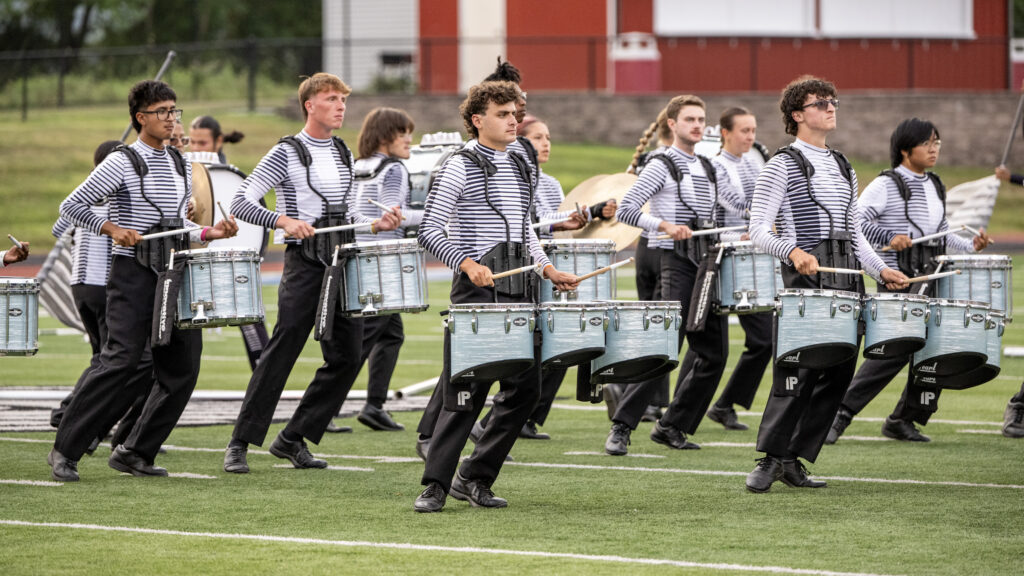DCI.org’s Mike Boo wrote introductions to each of the 12 drum corps shows that will be broadcast on the big screen at the DCI Classic Countdown. We’ll be running two more introductions each day. Here’s the fifth excerpt.
1996 Phantom Regiment
Right after DCI’s first championship tie was announced, a member of Phantom Regiment’s staff leaned over to me on the sideline and stated something on the order of, “I knew for us to finally win a title it would have to be under strange circumstances.” In the second year of the black uniforms, Phantom did what its legions of fans had hoped for over the previous two decades: It won the DCI World Championship. The fact that the corps tied with Blue Devils (for DCI’s first of three ties at the top over a five-year period) did not tarnish the effect of the accomplishment. If anything was shocking about the win, it was that Phantom had risen from fourth place in quarterfinals. Well, parts of the all-Shostakovich program were fairly shocking as well; especially the volume and intensity of the conclusion of the fill-in-the-blanks horn arc in the emotionally climactic “Symphony No. 5.” “Defiant Heart — The Music of Dmitri Shostakovich” opened in a manner most uncharacteristic of Phantom, soft and slow with only the contras playing. Slowly, the repetitive elegy layered emotion upon emotion to slap the faces of the fans with a brooding, full-bodied horn sound that rumbled the stadium seats like a jet engine warming up. It was so simple, so elegant and so effective. From then on, the audience was eating out of the corps’ hands. It was that “Finale from Symphony No. 5,” though, that really stole the show. With the guard projecting a bravado level of defiance worthy of the show title, the horn line laid the movement of the symphony on the line like it had never been performed before. It has last been performed in DCI World finals by Phantom in 1973 and 1974. In finals, the relentless pounding of the melodic strains and the rhythmic fury of the closer were unforgiving and dynamically furious. Any more emotional and it might have gone sailing over the top of the stadium. It was a perfect meeting of emotion with the restraint of technique, bringing the piece to the boiling point without allowing it to boil over all over the stove that the field had become. When it was over, all we could do was pant in exhaustion and wonder if somehow, Phantom Regiment had finally “done it.” And somehow, they had.
2000 Boston Crusaders
The Boston Crusaders were consistently one of the top corps in the activity for years and years, but when the DCI age hit, the corps experienced several trying seasons. The members never gave up, though, as the corps repeatedly made DCI membership with as few as 19 horns. The corps second golden age came along in 1999, when the corps finally made DCI World Championships. Just a year later, they placed fifth with a show fans have declared one of the best of the current decade. “Red,” a travelogue through the moods of the vivacious hue, was a production that firmly established the corps back in the ranks of top units. The music was searing, even when quiet, and the visual elements and liberal use of body sculpturing were perfectly suited to creating a new image for the corps. “Bolero” introduced many of the visual elements that were to define the corps, the rapid development of opening lines into widespread blocks, the body posturing utilizing members as statuettes, the sudden introduction of color where none had been. All became instant trademarks of the new Boston Crusaders, a corps that waited over a quarter century to make the “big show,” but suddenly was showing signs of owning it. The original “intensity” was brimming over with bombastic Spanish zeal, pushing the genre down the throats of the audience with a total lack of mercy. Fast, furious and fun, the piece further defined the corps as a unit that wasn’t reticent about communicating directly with both the newest and the most established fans. But it was “Passion,” based on “Time to Say Goodbye” that actually left many fans in tears. A repetitive drum pattern beat away obsessively, first seemingly from the distance and gradually evolving to the front of the musical spectrum. The hauntingly beautiful melodic line gradually bubbled up from simmering to boiling over. It was a work that chilled people down to the bones in their toes and made them want to throw each other over the stadium balcony in glee.





